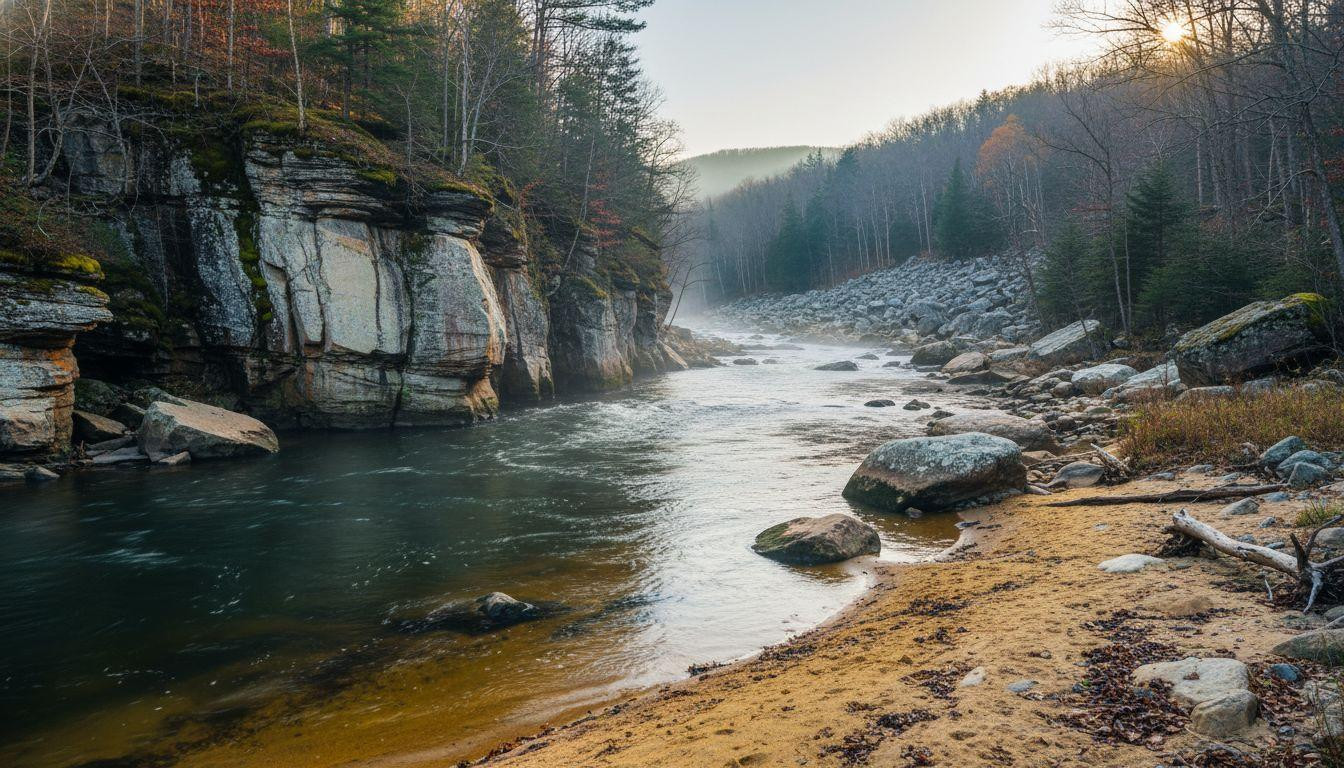Dawn breaks over White Haven at 6:47 AM as the Lehigh River catches November light through ancient Pocono forest. Mist rises from water cutting through granite while boulders the size of houses rest silent in a National Natural Landmark field. This isn’t the commercialized Pocono Mountains most travelers know. This is White Haven, where 15,990 acres of authentic wilderness begin 90 minutes from Manhattan, where genuine outdoor adventure costs less than resort amenities, and where trails empty of crowds three hours after sunrise.
Where wilderness hides between cities
White Haven sits in northeastern Pennsylvania’s Pocono Mountains, positioned between New York City (120 miles) and Philadelphia (110 miles). The town of 1,211 residents serves as gateway to Hickory Run State Park’s massive wilderness sanctuary. Interstate 476 carries travelers racing toward famous resort destinations while most miss the turnoff to authentic adventure.
Those who stop discover what commercialized Poconos abandoned: direct wilderness access without resort mediation. Trail systems lead to waterfalls and 20,000-year-old geological wonders. Water recreation happens on authentic rivers rather than artificial resort lakes. November temperatures hover around 45°F while autumn’s final colors cling to ridge lines. The nearest airport sits 40 minutes away in Wilkes-Barre.
What makes White Haven different from resort destinations
The geological wonder most travelers miss
Hickory Run State Park preserves Pennsylvania’s most extraordinary geological feature: a boulder field where rocks rest exactly where glacial processes deposited them over 20,000 years ago. This National Natural Landmark stretches across 20+ acres like an alien landscape. Boulders reach massive proportions, creating dramatic proof of ice age forces. Hawks Falls offers accessible waterfall drama reached via easy hiking trails.
River wilderness 90 minutes from Manhattan
The Lehigh River corridor protects 15,990 acres of pristine wilderness threading through northeastern Pennsylvania’s mountains. Deep green forest dominates year-round, interrupted by white water rapids and gray stone formations. November’s landscape transitions to bare branches with lingering amber tones. This reveals rock formations and valley vistas summer foliage conceals. Over 40 miles of hiking trails cover diverse terrain from yellow beaches to dark forests.
What happens in White Haven
Water adventures without resort prices
Whitewater Challenger and Yeti Watersports organize river tubing, kayaking, and canoeing on the Lehigh River. Groups consistently praise efficient operations and authentic river experiences. Recent visitors describe outstanding value compared to resort water activities. Eight-mile guided bike rides include waterfall stops where families splash in safe pools. Sand Spring Lake provides designated swimming from late May through mid-September.
Trail systems and fishing waters
Hickory Run’s trail network includes the Orchard Trail, Fireline Trail, Sand Spring Trail, and mysteriously named Shades of Death Trail. Native fish populations thrive throughout the region: pike, pickerel, large and smallmouth bass, catfish, perch, sunfish, and crappies. Francis E. Walter Dam and surrounding waterways offer excellent fishing opportunities. State fishing licenses are required for all angling activities.
The Pocono truth commercial resorts won’t tell
White Haven reveals what happened when the Poconos chose different paths decades ago. Major resort destinations built artificial lakes and indoor water parks charging $150+ nightly. White Haven preserved wilderness access and genuine outdoor experiences at budget-to-mid-range pricing. Accommodation ranges $80-200+ nightly depending on season and property type. The Hickory Run Lavender Farm and Holy Ghost Distillery add local character without overwhelming place authenticity.
November empties trails while maintaining accessibility. This creates the perfect balance between summer crowds and winter closures. Visitors discover solitude in vast natural landscapes just hours from major metropolitan areas. No resort mediation required for wilderness access.
Your questions about White Haven answered
How much does White Haven really cost?
Accommodation ranges $80-200+ nightly depending on season and property type. November through March (excluding holidays) offers significantly lower rates than peak summer. River activities and guided experiences price competitively with groups consistently noting excellent value. Hiking and state park access remain free to minimal cost. Dining reflects casual regional pricing rather than resort premiums.
What’s the best time to visit White Haven?
Late spring through early fall (May-September) offers optimal hiking and waterfall viewing with reliable weather. Summer provides warmest temperatures for water activities. Early fall attracts foliage viewers with pleasant hiking conditions. November represents true low-season with minimal crowds, lower prices, and trail accessibility without summer heat. Winter visitors seek snowshoeing opportunities in the boulder field.
How does White Haven compare to commercial Pocono resorts?
White Haven functions as authentic outdoor destination rather than curated resort experience. Advantages include lower tourist density, more affordable pricing, genuine wilderness access, and regional character preservation. Trade-offs include limited tourism infrastructure and basic rather than luxury accommodations. This appeals to travelers seeking outdoor authenticity and value over resort amenities and artificial entertainment.
At 4:08 PM, November sun drops behind western ridges while the Lehigh River glows amber between dark forest walls. Twenty-thousand-year-old boulders cast long shadows across the National Natural Landmark field. Steam rises from evening coffee as granite peaks catch final light. This remains the Pocono wilderness most travelers miss completely.
